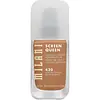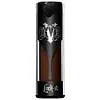What's inside
What's inside
 Key Ingredients
Key Ingredients

 Benefits
Benefits

 Concerns
Concerns

 Ingredients Side-by-side
Ingredients Side-by-side

Isododecane
EmollientWater
Skin ConditioningButylene Glycol
HumectantEthylhexyl Palmitate
EmollientTrimethylsiloxysilicate
EmollientPolymethylsilsesquioxane
PEG-10 Dimethicone
Skin ConditioningC24-28 Alkyldimethylsiloxy Trimethylsiloxysilicate
Skin ProtectingDimethicone
EmollientPolysilicone-11
Octyldodecyl Stearoyl Stearate
EmollientPEG/PPG-18/18 Dimethicone
EmulsifyingPolyethylene
AbrasiveTropaeolum Majus Flower/Leaf/Stem Extract
Skin ConditioningPhenoxyethanol
PreservativeEthylhexylglycerin
Skin ConditioningCaprylyl Glycol
EmollientPotassium Sorbate
PreservativeHexylene Glycol
EmulsifyingMagnesium Aluminum Silicate
AbsorbentCellulose Gum
Emulsion StabilisingXanthan Gum
EmulsifyingDisteardimonium Hectorite
StabilisingPropylene Carbonate
SolventC18-36 Acid
CleansingIsododecane, Water, Butylene Glycol, Ethylhexyl Palmitate, Trimethylsiloxysilicate, Polymethylsilsesquioxane, PEG-10 Dimethicone, C24-28 Alkyldimethylsiloxy Trimethylsiloxysilicate, Dimethicone, Polysilicone-11, Octyldodecyl Stearoyl Stearate, PEG/PPG-18/18 Dimethicone, Polyethylene, Tropaeolum Majus Flower/Leaf/Stem Extract, Phenoxyethanol, Ethylhexylglycerin, Caprylyl Glycol, Potassium Sorbate, Hexylene Glycol, Magnesium Aluminum Silicate, Cellulose Gum, Xanthan Gum, Disteardimonium Hectorite, Propylene Carbonate, C18-36 Acid
Dimethicone
EmollientWater
Skin ConditioningPhenyl Trimethicone
Skin ConditioningTrimethylsiloxysilicate
EmollientPEG/PPG-18/18 Dimethicone
EmulsifyingAluminum Starch Octenylsuccinate
AbsorbentSilica Dimethicone Silylate
AbsorbentButylene Glycol
HumectantIsononyl Isononanoate
EmollientIsododecane
EmollientGlycerin
HumectantSodium Chloride
MaskingDimer Dilinoleyl Dimer Dilinoleate
EmollientGlyceryl Caprylate
EmollientMethicone
EmollientSorbitan Sesquioleate
EmulsifyingCI 77220
Cosmetic ColorantTrihydroxystearin
Skin ConditioningPolysilicone-11
Potassium Sorbate
PreservativeDimethicone Crosspolymer
Emulsion StabilisingMethylpropanediol
SolventTalc
AbrasiveDisodium EDTA
Caprylhydroxamic Acid
CI 77891
Cosmetic ColorantIron Oxides
Dimethicone, Water, Phenyl Trimethicone, Trimethylsiloxysilicate, PEG/PPG-18/18 Dimethicone, Aluminum Starch Octenylsuccinate, Silica Dimethicone Silylate, Butylene Glycol, Isononyl Isononanoate, Isododecane, Glycerin, Sodium Chloride, Dimer Dilinoleyl Dimer Dilinoleate, Glyceryl Caprylate, Methicone, Sorbitan Sesquioleate, CI 77220, Trihydroxystearin, Polysilicone-11, Potassium Sorbate, Dimethicone Crosspolymer, Methylpropanediol, Talc, Disodium EDTA, Caprylhydroxamic Acid, CI 77891, Iron Oxides
Ingredients Explained
These ingredients are found in both products.
Ingredients higher up in an ingredient list are typically present in a larger amount.
Butylene Glycol (or BG) is used within cosmetic products for a few different reasons:
Overall, Butylene Glycol is a safe and well-rounded ingredient that works well with other ingredients.
Though this ingredient works well with most skin types, some people with sensitive skin may experience a reaction such as allergic rashes, closed comedones, or itchiness.
Learn more about Butylene GlycolDimethicone is a type of synthetic silicone created from natural materials such as quartz.
What it does:
Dimethicone comes in different viscosities:
Depending on the viscosity, dimethicone has different properties.
Ingredients lists don't always show which type is used, so we recommend reaching out to the brand if you have questions about the viscosity.
This ingredient is unlikely to cause irritation because it does not get absorbed into skin. However, people with silicone allergies should be careful about using this ingredient.
Note: Dimethicone may contribute to pilling. This is because it is not oil or water soluble, so pilling may occur when layered with products. When mixed with heavy oils in a formula, the outcome is also quite greasy.
Learn more about DimethiconeIsododecane is a fragrance, emollient, and solvent.
As an emollient, it helps your skin stay soft and hydrated. Emollients help trap moisture into your skin.
Isododecane's role as a solvent makes it a great texture enhancer. It spreads smoothly on skin and does not leave a sticky feeling behind. Isododecane also helps prevent color transfer in makeup products.
Isododecane is not absorbed into skin.
Learn more about IsododecanePEG/PPG-18/18 Dimethicone is a type of silicone.
Polysilicone-11 is a film-forming silicone that creates a non-tacky and matte finish on the skin. It's commonly used to improve texture, absorb excess oil, and help active ingredients spread evenly.
Due to its "rubber-like" structure, it stays on the skin's surface instead of being absorbed. On the skin, it creates a flexible layer that enhances wearability and stability.
Potassium Sorbate is a preservative used to prevent yeast and mold in products. It is commonly found in both cosmetic and food products.
This ingredient comes from potassium salt derived from sorbic acid. Sorbic acid is a natural antibiotic and effective against fungus.
Both potassium sorbate and sorbic acid can be found in baked goods, cheeses, dried meats, dried fruit, ice cream, pickles, wine, yogurt, and more.
You'll often find this ingredient used with other preservatives.
Learn more about Potassium SorbateThis silicone is an emollient. Emollients create a thin film on the skin to prevent moisture from escaping.
It is not soluble in water and helps increase water-resistance in products.
According to a manufacturer, it can blend seamlessly with silicone oils, such as Cyclopentasiloxane.
Learn more about TrimethylsiloxysilicateWater. It's the most common cosmetic ingredient of all. You'll usually see it at the top of ingredient lists, meaning that it makes up the largest part of the product.
So why is it so popular? Water most often acts as a solvent - this means that it helps dissolve other ingredients into the formulation.
You'll also recognize water as that liquid we all need to stay alive. If you see this, drink a glass of water. Stay hydrated!
Learn more about Water